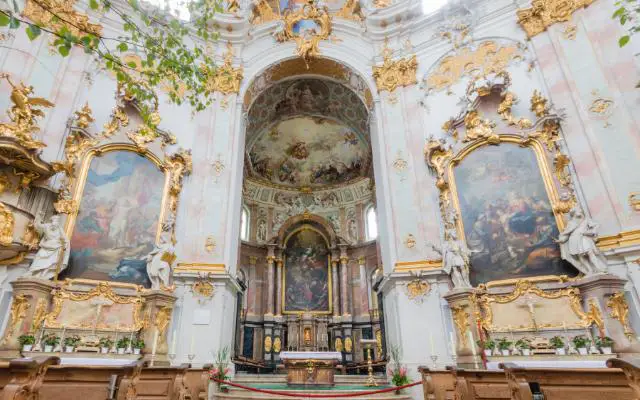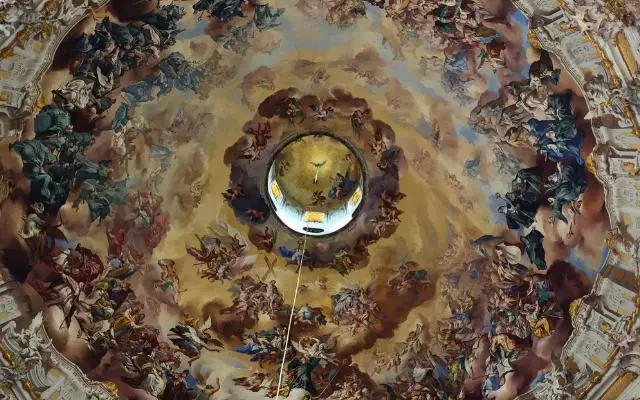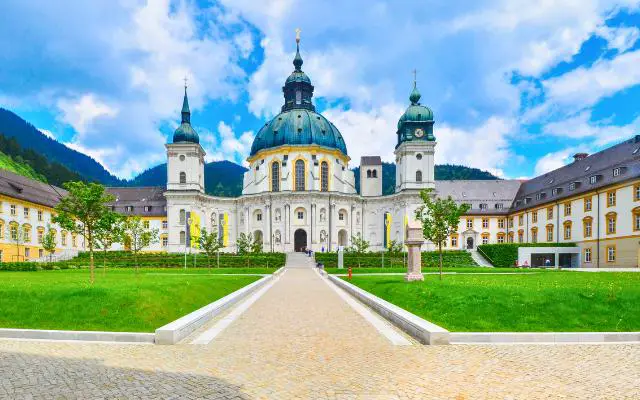Ettal Abbey is a Benedictine monastery located in the small village of Ettal in Bavaria, Germany, and today, it’s a popular tourist destination that attracts visitors from all over the world.
We’ve been lucky enough to visit the monastery here at Ettal a few times and are always surprised at how Incredible the place is and equally astounded at its lack of popularity in the region. For us, it’s a must-visit cathedral with an amazing interior like none other we’ve come across before.
With beautiful architecture, stunning frescoes, and a very cool brewery that couples with a very interesting and lengthy history, this is a destination you don’t want to miss if in this area of Germany in southern Bavaria.
In this comprehensive guide to the Ettal Abbey in Bavaria, we’ll uncover all there is to know. So let’s crack on, shall we?
The Importance of the Abbey in Bavaria
Ettal Abbey is a working Benedictine monastery in Bavaria that has been an important religious and cultural site in Bavaria for over 700 years.
The abbey was founded in 1330 by Emperor Ludwig the Bavarian. Its location in the foothills of the Alps made it an ideal place for a monastery, as it provided a peaceful and secluded environment for the monks to live and work.
Over the centuries, the abbey has played an important role in the religious and cultural life of Bavaria. It has been a center of learning, with a renowned library and school.
The abbey has also been a center of art, with its beautiful baroque church and other buildings.
The abbey has survived many challenges over the centuries, including wars, fires, and financial difficulties. Today, it remains an important cultural and religious site in Bavaria, attracting tourists from across the globe.
In addition to its religious and cultural significance, the abbey is also an important economic driver in the region. It employs many people in the village of Ettal and supports local businesses.

Historical Background of Ettal Abbey
Founding in 1330 by Louis IV
Ettal Abbey, also known as Kloster Ettal, or the Ettal Monastery is a Benedictine monastery that was founded here in Ettal in 1330 by Louis IV, Holy Roman Emperor, as a gesture of gratitude for his victory in the Battle of Ampfing against the Habsburgs.
The original purpose of the abbey was to provide a place of worship and refuge for both travelers and pilgrims.
Evolution Over the Centuries
Over the centuries, Ettal Abbey has undergone significant changes and expansions.
In the 18th century, the abbey was rebuilt in the Baroque style by Johann Jakob Herkomer. The church was expanded and adorned with frescoes, stucco work, and sculptures.
The abbey also became a center for education, with a school and library established.
The War Years
During World War II, Ettal Abbey was used as a military hospital by the German army and after the war, the abbey was restored and reopened to the public.
Today, Ettal Abbey is still an active Benedictine monastery, with about 50 monks living and working on the premises. Visitors can tour the abbey church, library, and museum, as well as purchase products made by the monks, such as beer, wine, liqueur, and even cheese.

Architectural Highlights of the Abbey
The Mighty Basilica
Ettal Abbey’s Basilica is an impressive example of Baroque architecture.
The basilica’s interior is adorned with intricate frescoes and stucco work, and the high altar is made of white marble. The basilica’s dome is a prominent feature of the structure and is supported by four massive pillars.
Visitors can also admire the beautiful stained glass windows that depict scenes from the Bible.
The Magnificent Rococo Vestry
The Vestry of Ettal Abbey is a stunning example of Rococo architecture.
The walls are adorned with intricate stucco work and frescoes, and the ceiling is decorated with a beautiful painting of the Holy Spirit.
The vestry is also home to a collection of valuable liturgical objects, including chalices, ciboriums, and monstrances.
Unique Monastery Grounds
The monastery grounds of Ettal Abbey are a unique blend of Baroque and Rococo architecture.
Visitors can explore the monastery’s cloisters, which are adorned with frescoes and stucco work. The monastery also features a beautiful garden, which is home to a variety of plants and flowers.
Visitors can relax and enjoy the peaceful surroundings while taking in the beauty of the abbey’s architecture and the surrounding mountains.
The Monastery Library
Ettal Abbey is home to a magnificent library that houses over 150,000 volumes of books, manuscripts, and other important documents. The library is located on the first floor of the monastery and is open to visitors for guided tours.
Treasures and Significant Manuscripts
The library’s collection includes many significant manuscripts and books dating back to the medieval period.
Here you can view the original handwritten manuscripts of famous composers such as Mozart and Beethoven. The library also has a collection of rare books, including first editions of works by famous authors such as Goethe and Schiller.
One of the most significant manuscripts in the collection is the Codex Aureus of Echternach, a gospel book from the 11th century that is adorned with gold and precious stones.
The library also has a collection of illuminated manuscripts, including the famous Book of Hours.
Importance to Bavaria’s Cultural Heritage
The library at Ettal Abbey is an important part of Bavaria’s cultural heritage. It is considered one of the most important monastic libraries in Germany and has been designated as a cultural monument by the Bavarian government.
The library’s collection is a testament to the importance of preserving cultural heritage. It contains works that have been carefully preserved for centuries and serves as a reminder of the importance of preserving knowledge and art for future generations.

Ettaler Klosterbiere (Ettal Brewery)
Ettal Abbey is home to a brewery that produces some of the finest beers in the region. The Ettaler Klosterbiere has been in operation since the 1600s and is known for its unique brewing techniques and high-quality ingredients.
The brewery produces a range of beers, including lagers, ales, and wheat beers. The most popular beer is the Ettaler Kloster Dunkel, a dark lager with a rich, malty flavor.
Other popular beers include the Ettaler Kloster Helles, a light lager, and the Ettaler Kloster Weizen, a wheat beer.
There are tours of the brewery available where you’ll be educated about the entire brewing process. The tour includes a visit to the brewery’s museum, where visitors can see historic brewing equipment and learn about the history of the brewery and beer.
In addition to the brewery tour, visitors can also enjoy a beer tasting at the abbey’s beer garden. The beer garden is a popular spot for locals and tourists alike, and offers a relaxed atmosphere to enjoy a cold beer and some traditional Bavarian food.
Overall, the Ettaler Klosterbiere is a must-visit for beer lovers visiting Ettal Abbey. With its rich history, unique brewing techniques, and high-quality ingredients, it’s no surprise that the brewery has become a beloved institution in the region.
Ettal Abbey’s Role in Modern Bavaria Today
Housing and Support for Refugees (e.g., Ukrainian Refugees)
Ettal Abbey has played an important role in providing housing and support for refugees in modern Bavaria.
In 2014, the abbey opened its doors to Ukrainian refugees who were fleeing conflict in their home country. The abbey provided temporary housing and support for these refugees as they adjusted to their new lives in Germany.
The abbey’s efforts to support refugees have continued in the years since.
In 2015, the abbey provided housing for Syrian refugees who were seeking asylum in Germany. The abbey also offers language classes and other support services to refugees who are living in the area.
Educational Endeavors: School Buildings and Their Significance
The Abbey has a long history of educational endeavors, and this tradition continues today. The abbey operates a boarding school for boys, which has been in operation since the 16th century.
The school provides a rigorous academic program, as well as opportunities for students to participate in sports and other extracurricular activities.
In addition to the boarding school, the abbey also operates a vocational school, which offers training in a variety of trades. The vocational school has a strong reputation for producing skilled workers who are in high demand in the local economy.
The school buildings themselves are also significant. The abbey’s Baroque-style buildings are considered to be some of the finest examples of this architectural style in Bavaria.
The buildings have been well-preserved over the centuries, and they continue to be an important part of the abbey’s educational mission.
Overall, Ettal Abbey’s role in modern Bavaria is multifaceted, encompassing both its historical significance and its ongoing efforts to support refugees and provide educational opportunities for young people.

Ettal Abbey’s Location & Surroundings
The abbey is situated in the foothills of the Bavarian Alps, surrounded by stunning natural beauty. Visitors to the monastery will find themselves in a serene and peaceful setting, perfect for contemplation and reflection.
Proximity to Oberammergau and Garmisch-Partenkirchen
Ettal Abbey is located just a short distance from the towns of Oberammergau and Garmisch-Partenkirchen.
These charming Bavarian towns are known for their beautiful architecture, rich history, and stunning natural surroundings. Visitors to Ettal Abbey can easily explore these towns and experience all they have to offer in the same trip to this region.
The Scenic Ammer and Loisach Valleys
The abbey is situated in the scenic Ammer and Loisach valleys, which are known for their stunning natural beauty.
Hikers love this area for its picturesque walking trails through the nearby valleys where they’ll enjoy the breathtaking views of the surrounding mountains and forests.
The valleys are also home to a wide variety of wildlife, including deer, foxes, and birds of prey.
The Benedictine Monks of Ettal Monastery
Daily Life and Routines
The Benedictine Monks of Ettal Monastery follow a strict daily routine that revolves around prayer, work, and community life. They wake up early in the morning, usually around 5:00 am, to attend the first prayer of the day, known as Vigils. This is followed by Lauds, Mass, and breakfast.
After breakfast, the monks engage in manual labor, which includes farming, brewing beer, and carpentry. The monks also dedicate a significant amount of time to studying and reading, which is an essential part of their spiritual and intellectual growth.
They also observe strict silence during certain times of the day, such as during meals or when they are working which allows them to focus on their spiritual practices and cultivate a deeper sense of inner peace.
Their Role in Maintaining the Abbey and Its Traditions
The Benedictine Monks of Ettal Monastery play a crucial role in maintaining the abbey and its traditions. They are responsible for the upkeep of the buildings, gardens, and grounds, as well as the production of various goods, such as beer, cheese, and honey.
The monks also serve as spiritual leaders and mentors to the local community and visitors. They offer retreats, spiritual guidance, and counseling services to those seeking a deeper understanding of their faith.
In addition to their spiritual and practical duties, the monks also participate in various cultural and social events, such as concerts, lectures, and festivals. These events help to promote the abbey’s mission of fostering a sense of community and cultural exchange.

Visiting Ettal Abbey
If you’re planning a trip to Ettal Abbey the below should reveal all you need to know but of course, as always, don’t forget to check the website before making any visit.
Guided Tours and What to Expect
Guided tours are available for visitors who want to learn more about the history and architecture of Ettal Abbey. The tours are conducted in German, but English audio guides are available.
The tour takes approximately one hour and includes a visit to the church, the library, and the brewery. Visitors are also welcome to explore the monastery on their own.
The church is the main attraction of Ettal Abbey. It is a stunning example of Baroque architecture and features beautiful frescoes and sculptures.
The library is also worth a visit, as it contains over 100,000 books and manuscripts. The brewery produces some of the best beer in the region and visitors can sample it during the tour.
Tips for Visitors and Best Times to Visit
- Ettal Abbey is open to visitors all year round, but the best time to visit is during the summer months when the weather is mild and the gardens are in bloom.
- The monastery can get busy during peak season (generally with German tourists) so it’s best to arrive early in the morning or late in the afternoon to avoid any crowds.
- Visitors should dress modestly appropriate when visiting any religious site and the Abbey here is no different.
- Photography is not permitted in some parts of the building so please take careful note of signage.
- Parking is available near the monastery, but it can be limited during peak season.
- Visitors can also reach Ettal Abbey by train or bus from nearby towns.
Ettal Abbey is a perfect destination for a day trip or a weekend getaway from Munich and is very easy to get to.

Conclusion/Final Thoughts
Ettal Abbey is a remarkable Benedictine monastery that has stood the test of time. Its rich history, stunning architecture, and religious significance make it a must-visit destination for anyone interested in history, architecture, or religion.
The abbey has played a significant role in shaping the religious and cultural landscape of the region and continues to influence the lives of many people today.
Visitors to Ettal Abbey will find a wealth of information about the abbey’s history and the Benedictine way of life and honestly, we love visiting Ettal Abbey and we sincerely hope you’ll be encouraged to explore and appreciate its history for yourself.
Whether you are interested in history, architecture, or religion, a visit to Ettal Abbey is sure to be a rewarding experience.
Cheers and thanks for reading!
Do you love Kloster Hunting like we do – if so check out this article – Kloster Andechs Monastery

